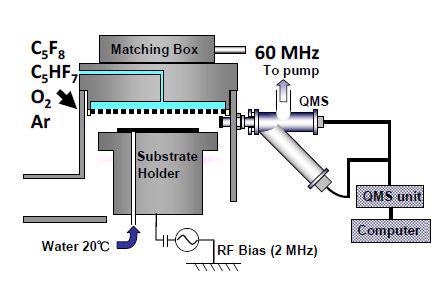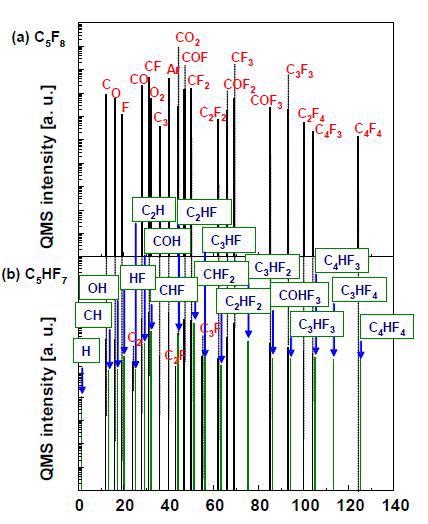Significant ionic and neutral species, including CxFy (X>2), CxHFy, and CxFy (Y/X<2), have been reported by quadrupole mass-spectroscopy in the unique C5HF7/O2/Ar plasma. When compared to conventional C5F8/O2/Ar plasmas, it was determined that plasma etching of SiO2 films with increased selectivity against SiN films was obtained using the C5HF7/O2/Ar plasma.
In line with the results of this analysis, the mechanism involved the creation of a thicker C-rich fluorocarbon film on SiN made possible by impinging the C-rich hydrofluorocarbon species, characterised in the novel plasma.
Experimental Procedure and Results
Using electro-impact ionization, C5F8 and C5HF7 are primarily fragmented into C3F3 and C3HF2, respectively at 70eV. H-containing species were explicitly detected in the fragmentation pattern for C5HF7 by the replacement of one F atom with one H atom, i.e. CF2→CHF, C2F2→C2HF, CF3→CHF2 and so on. Figure 1 shows a schematic of experimental apparatus.

Figure 1. Schematic of experimental apparatus
In real dielectric etching plasma, it is a known fact that ionization, dissociation and attachment take place by colliding with electrons typically having a Maxwellian energy of a few eV. Hence, a considerable difference occurs in gas chemistries between neutral species with and without H atoms for the actual C5F8/O2/Ar and C5HF7/O2/Ar plasmas.
The results in Figure 2 showed C5F8→CF2+C4F6 as the primary dissociation pathway of the cyclic C5F8 molecules. Also, multiple dissociations caused smaller fragmentations consequent to the reactions; CF2→CF+F, or C4F6→C3F3+ CF3. This enables the detection of large fractions of CF3, CF2, CF, C3F3 and each associated H-substituted species, including CHF2, CHF, CH, and C3HF2.

Figure 2. Quadrupole mass analytical results of neutrals in C5F8/O2/Ar or C5HF7/O2/Ar plasmas
Also, the position of the entrance of the quadrupole mass spectrometer was at the commercialized reactor’s chamber wall, which meant that only data regarding the positive ion composition at the closed chamber wall excluding the sample surface could be yielded.
Along with Ar+, the other ions detected include CF3+, CF2+ and CF+. Since, selective formation of the C-rich fluorocarbon layer on SiN films was achieved, the nature of large molecular ions – CxFy or CxHFy and selective etching of SiO2 films coincided.
Conclusion
The key focus of the research was on characterizing gas molecules for the improvement of etching. The main aspects that enhance etching performance are selectivity of the material, etched profile control and etch rates, which are surface reactions following plasma chemical properties.
Feedstock gases are thus considered a major concern. While etching SiO2, the key gases of selection have changed over a period of time, for example, CF4, C2F6, C4F8, C4F6, and C5F8. Furthermore, H- and O-containing species such as CHF3, CH2F2, C3F6O, C5F10O, etc can be used as controls, considering the quantity of F atoms used in the plasma chemistry.
Understanding the relationship between the chemistry of new gases and the etching properties is very important for industrial and scientific purposes. Hence, further research will focus on understanding the etching mechanism through gas phase and surface analysis diagnostics.

This information has been sourced, reviewed and adapted from materials provided by Hiden Analytical.
For more information on this source, please visit Hiden Analytical.